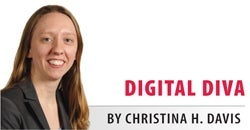While we weren’t paying attention, the office changed. All you have to do is watch an episode of Mad Men to be reminded just how much it’s changed. Gone are the days of the steno pool typing memos. Here are the days where we all have to type 60 words per minute and know how to work PowerPoint. The era of two-martini lunches has been traded for nibbling a sandwich at your desk — if you’re lucky.
What do we do to cope with all these changes?
Well, one local expert is doing her part to help us all out, in the form of a book called, “New Rules for Today’s Workplace,” scheduled to be released by Houghton Mifflin Harcourt next year.
Phoning It In
The author is Sheryl Lindsell-Roberts, who happens to be a resident of Marlborough. She’s owned her own marketing and communications firm for 20 years and has written a number of books on various business topics.
But her new book is the first time she’s tried to grapple with the myriad ways that all of our jobs are changing thanks to technology. In a way, the book is like a user manual for the office worker of the 21st century, which is rather helpful, considering most of us are just figuring this stuff out on the fly.
One the sections of the book I immediately gravitated to was on managing virtual meetings. I don’t know about you, but I’ve sat through some pretty useless web meetings and phone conferences. I was anxious to get Lindsell-Roberts advice on how to make sure my next meeting actually gets something accomplished.
As it turns out, a virtual meeting — where several people are calling into a conference line and using web conferencing software like WebEx or GoToMeeting — requires the same key ingredient as old-fashioned in-person meetings: preparation.
“It’s all about preparing for the meeting and getting the right people to attend,” Lindsell-Roberts told me. So that means having a very tight agenda, starting on time and ending on time. Unlike an in-person meeting, Lindsell-Roberts pointed out that you can’t have extraneous people with a remote interest join a virtual meeting. Those without a major stake in the conversation will just sit on the phone twiddling their thumbs growing more and more insulted that you’ve wasted their time. If people don’t need to be directly involved in the meeting, but should be kept abreast of what was decided, she suggested sending out the minutes of the meeting. (There’s another tip embedded there: Make sure someone takes notes at your meetings and types them up in a prompt fashion.)
Reply All
The other key chapter of the book is on an oldie, but a goodie: E-mail. Frequent readers of this column have witnessed me rail against the misuse of e-mail, so I was particularly happy to see an entire section on the topic.
First, Lindsell-Roberts points out the limitations of e-mail.
“E-mail is one-way communication and people often lose sight of that,” she said. In other words, it can’t replace a phone call or (heaven forbid) getting away from your desk and actually looking someone in the eye.
For those communications where e-mail is an effective tool, Lindsell-Roberts advises her readers to make sure the subject line on any e-mail tells a story. In her book she uses the following examples:
Instead of writing… Write…
Profit report 12% profit expected for Q1
Staff meeting Staff meeting rescheduled to May 2 at 2:00
Hi Thanks for sending the report so quickly
Wouldn’t you love to be on the receiving end of some of those subject lines? I might actually walk across the office and give the sender a kiss in gratitude… Or maybe not. In today’s workplace that’s considered sexual harassment.
Lindsell-Roberts also gave me an interesting tip during our interview that I’m going to try — edit the subject line of the e-mail when you reply to make it clear what stage of the topic is being discussed. Haven’t we all be involved in a long stream of e-mails where the final message bears little resemblance to the original subject line? I’ve always left the subject line intact thinking it would confuse me later if I started changing it. But Lindsell-Roberts suggested that it would be more efficient to retain a key phrase in the subject line and then note the new subtopic. For example, if you’re discussing Policy ABC, the first subject line may read, “Policy ABC: Draft.” Then, later in an exchange, the subject may switch to, “Policy ABC: Final Version, need your approval.” That way you can easily keep track of those messages in your in-box while still being very specific about what the latest e-mail communication is about. Brilliant, isn’t it?
Beyond very specific tips and tricks, Lindsell-Roberts said that she hopes readers of her book take away a simple, yet important message:
“Technology is an incredible tool, but that’s all it is, a tool,” she said. “It’s never going to take the place of personalizing things.”
Truer words have never been said. Now, let me get back to reading my e-mails…
Got news for our Digital Diva column? E-mail Christina H. Davis at cdavis@wbjournal.com.

